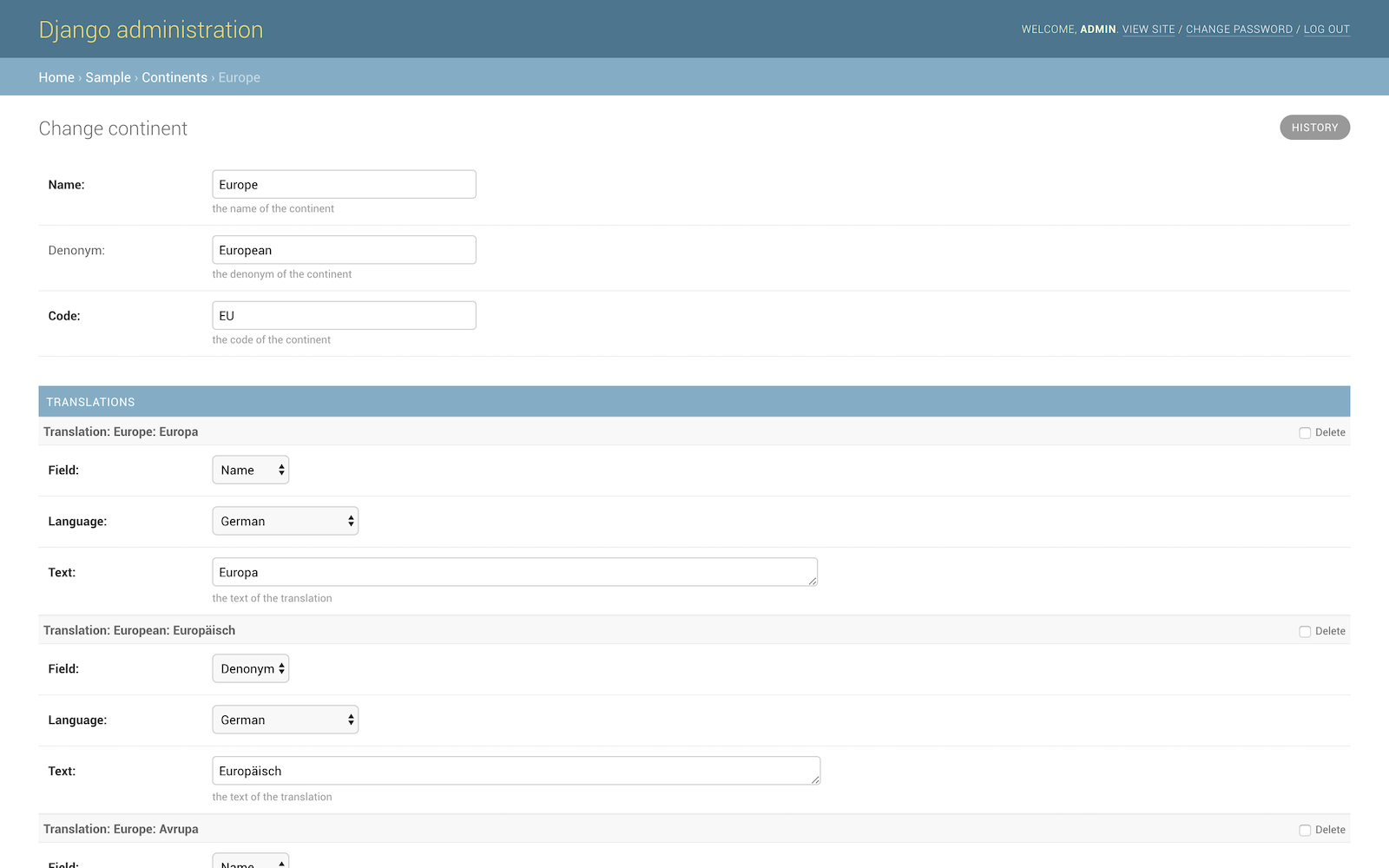
Security News
OWASP 2025 Top 10 Adds Software Supply Chain Failures, Ranked Top Community Concern
OWASP’s 2025 Top 10 introduces Software Supply Chain Failures as a new category, reflecting rising concern over dependency and build system risks.
django-translations
Advanced tools
Django model translation for perfectionists with deadlines.
There are two types of content, each of which has its own challenges for translation:
Static content: This is the content which is defined in the code. e.g. "Please enter a valid email address."
Django already provides a solution for translating static content.
Dynamic content: This is the content which is stored in the database. (We can't know it beforehand!)
Django Translations provides a solution for translating dynamic content.
Currently, this project is incompatible with PostgreSQL.
Install Django Translations using pip:
$ pip install django-translations
Add translations to the INSTALLED_APPS in the settings of your
project:
INSTALLED_APPS += [
'translations',
]
Run migrate:
$ python manage.py migrate
Configure Django internationalization and localization settings:
USE_I18N = True # use internationalization
USE_L10N = True # use localization
MIDDLEWARE += [ # locale middleware
'django.middleware.locale.LocaleMiddleware',
]
LANGUAGE_CODE = 'en-us' # default (fallback) language
LANGUAGES = ( # supported languages
('en', 'English'),
('en-gb', 'English (Great Britain)'),
('de', 'German'),
('tr', 'Turkish'),
)
Please note that these settings are for Django itself.
Inherit Translatable in any model you want translated:
from translations.models import Translatable
class Continent(Translatable):
code = models.Charfield(...)
name = models.Charfield(...)
denonym = models.Charfield(...)
class TranslatableMeta:
fields = ['name', 'denonym']
No migrations needed afterwards.
Use the admin extensions:
from translations.admin import TranslatableAdmin, TranslationInline
class ContinentAdmin(TranslatableAdmin):
inlines = [TranslationInline,]
This provides specialized translation inlines for the model.

Use the queryset extensions:
>>> from sample.models import Continent
>>> continents = Continent.objects.all(
... ).distinct( # familiar distinct
... ).probe(['en', 'de'] # probe (filter, exclude, etc.) in English and German
... ).filter( # familiar filtering
... countries__cities__name__startswith='Köln'
... ).translate('de' # translate the results in German
... ).translate_related( # translate these relations as well
... 'countries', 'countries__cities',
... )
>>> print(continents)
<TranslatableQuerySet [
<Continent: Europa>,
]>
>>> print(continents[0].countries.all())
<TranslatableQuerySet [
<Country: Deutschland>,
]>
>>> print(continents[0].countries.all()[0].cities.all())
<TranslatableQuerySet [
<City: Köln>,
]>
This provides a powerful yet familiar interface to work with the querysets.
Use the translation context:
>>> from translations.context import Context
>>> from sample.models import Continent
>>> continents = Continent.objects.all()
>>> relations = ('countries', 'countries__cities',)
>>> with Context(continents, *relations) as context:
... context.read('de') # read the translations onto the context
... print(':') # use the objects like before
... print(continents)
... print(continents[0].countries.all())
... print(continents[0].countries.all()[0].cities.all())
...
... continents[0].countries.all()[0].name = 'Change the name'
... context.update('de') # update the translations from the context
...
... context.delete('de') # delete the translations of the context
...
... context.reset() # reset the translations of the context
... print(':') # use the objects like before
... print(continents)
... print(continents[0].countries.all())
... print(continents[0].countries.all()[0].cities.all())
:
<TranslatableQuerySet [
<Continent: Asien>,
<Continent: Europa>,
]>
<TranslatableQuerySet [
<Country: Deutschland>,
]>
<TranslatableQuerySet [
<City: Köln>,
]>
:
<TranslatableQuerySet [
<Continent: Asia>,
<Continent: Europe>,
]>
<TranslatableQuerySet [
<Country: Germany>,
]>
<TranslatableQuerySet [
<City: Cologne>,
]>
This can CRUD the translations of any objects (instance, queryset, list) and their relations.
For more interesting capabilities browse through the documentation.
To support the project you can:
FAQs
Django model translation for perfectionists with deadlines.
We found that django-translations demonstrated a healthy version release cadence and project activity because the last version was released less than a year ago. It has 1 open source maintainer collaborating on the project.
Did you know?

Socket for GitHub automatically highlights issues in each pull request and monitors the health of all your open source dependencies. Discover the contents of your packages and block harmful activity before you install or update your dependencies.

Security News
OWASP’s 2025 Top 10 introduces Software Supply Chain Failures as a new category, reflecting rising concern over dependency and build system risks.

Research
/Security News
Socket researchers discovered nine malicious NuGet packages that use time-delayed payloads to crash applications and corrupt industrial control systems.

Security News
Socket CTO Ahmad Nassri discusses why supply chain attacks now target developer machines and what AI means for the future of enterprise security.